
When Does the Sun Rise and Set? Sunrise and sunset times cycle is a familiar part of our lives that impacts our routines and activities. But have you ever wondered about the specifics of sunrise and sunset times? When exactly does the sun come up and go down each day? And how do sunrise and sunset times change throughout the year?
This in-depth guide covers everything you need to know about daily, monthly, and seasonal variations in sunrise and sunset times. We’ll explore how factors like location, time of year, and Daylight Saving Time impact sunrise and sunset. Read on to become an expert on predicting sun rise and set times no matter where you are.
- What Defines Sunrise and Sunset Times?
- When Does the Sun Rise and Set?
- Factors That Impact Sunrise and Sunset Times
- Location/Latitude
- Time of Year
- Daylight Saving Time
- Atmospheric Refraction
- Elevation and Obstructions
- How to Calculate Precise Sunrise and Sunset Times
- Use Online Sunrise/Sunset Calculators
- Calculate Manually Using Sunrise/Sunset Formulas
- How Sunrise and Sunset Times Change Throughout the Year
- Sunrise and Sunset Azimuths
- Sunrise and Sunset Duration
- Twilights and Golden Hours
- Civil Twilight
- Nautical Twilight
- Astronomical Twilight
- Sunrise and Sunset by Location
- Tropical and Equatorial Latitudes (0° to 23° N/S)
- Subtropical Latitudes (23° to 35° N/S)
- Temperate Latitudes (35° to 50° N/S)
- Subpolar Latitudes (50° to 70° N/S)
- Polar Latitudes (70° to 90° N/S)
- Sunrise and Sunset by Longitude
- Unique Sunrises and Sunsets Around the World
What Defines Sunrise and Sunset Times?
Before diving into the specifics, let’s review the basic definitions of sunrise and sunset:
- Sunrise is the moment when the upper edge of the sun first appears over the eastern horizon in the morning.
- Sunset is the moment when the upper edge of the sun disappears below the western horizon in the evening.
Sunrise and sunset times are determined by the rotation of the Earth and the position of the sun. As the Earth rotates on its axis, any given location will face towards and away from the sun, experiencing daytime and nighttime. Sunrise marks the start of daytime and sunset the start of nighttime for a given location.
When Does the Sun Rise and Set?
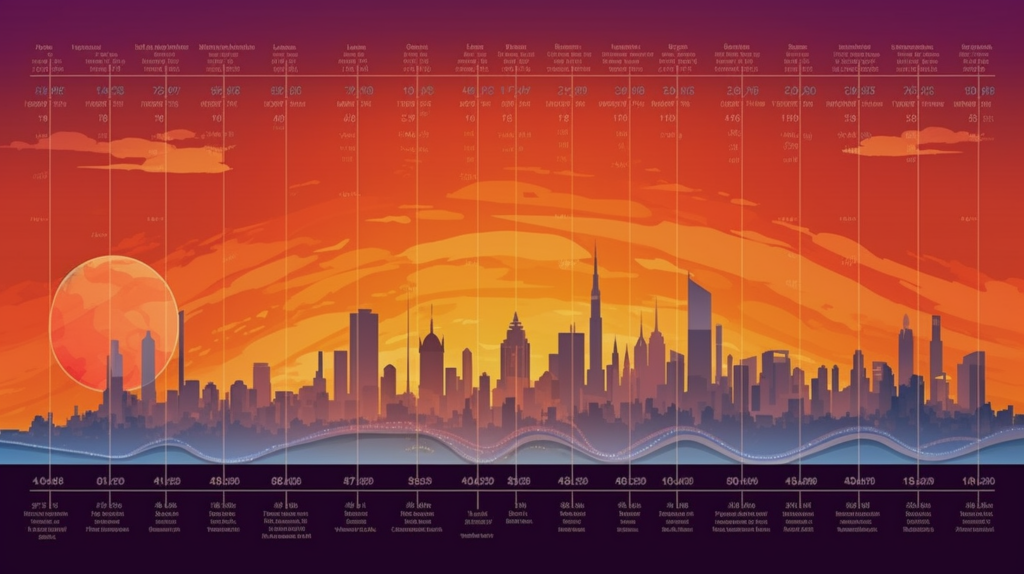
Want to take a rough guess at sunrise and sunset times for your location? Here are some average guidelines:
- Spring – sunrise is around 6 AM, sunset around 6 PM
- Summer – sunrise is around 5 AM, sunset around 8 PM
- Fall – sunrise is around 6:30 AM, sunset around 6 PM
- Winter – sunrise is around 7 AM, sunset around 5 PM
Of course, these are just general estimates that will vary by your exact location and time of year. But it provides a decent ballpark range to expect for sunrise and sunset times in each season.
Later in this article we’ll go over more precise ways to calculate the exact sunrise and sunset times on any given day.
Factors That Impact Sunrise and Sunset Times
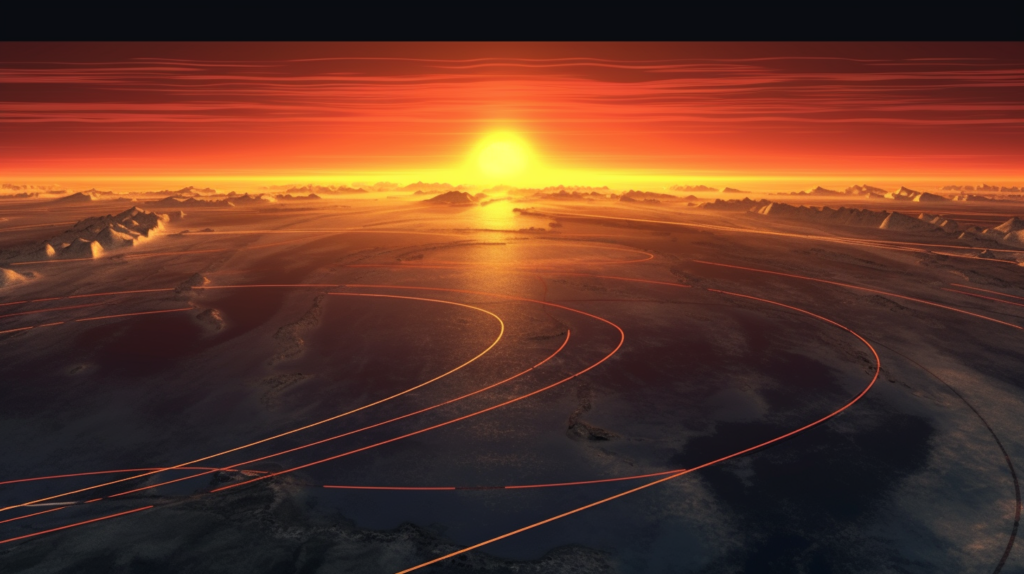
Many different factors impact the precise sunrise and sunset times for a given location on a given day. The main influences are:
Location/Latitude
Locations at higher latitudes (farther from the equator) will experience earlier sunrises in summer and later sunrises in winter. For example:
- Miami, Florida latitude: 26°N
- Sunrise in June: around 6:30 AM
- Sunrise in December: around 7 AM
- Seattle, Washington latitude: 47°N
- Sunrise in June: around 5 AM
- Sunrise in December: around 7:30 AM
So the farther north you are, the more variance you’ll see in sunrise/sunset times between summer and winter.
Time of Year
The dates and season impact sunrise and sunset times due to the tilt of the Earth’s axis of rotation.
- During the spring and fall equinoxes (around March 20 and September 22), daylight and nighttime hours are roughly equal. Sunrise and sunset times are intermediate.
- During the summer solstice (around June 21) at locations north of the equator, we experience the longest days and shortest nights. Sunrise is very early and sunset late.
- The opposite occurs at the winter solstice (around December 21) when locations north of the equator have their shortest days and longest nights. Sunrise is late and sunset early.
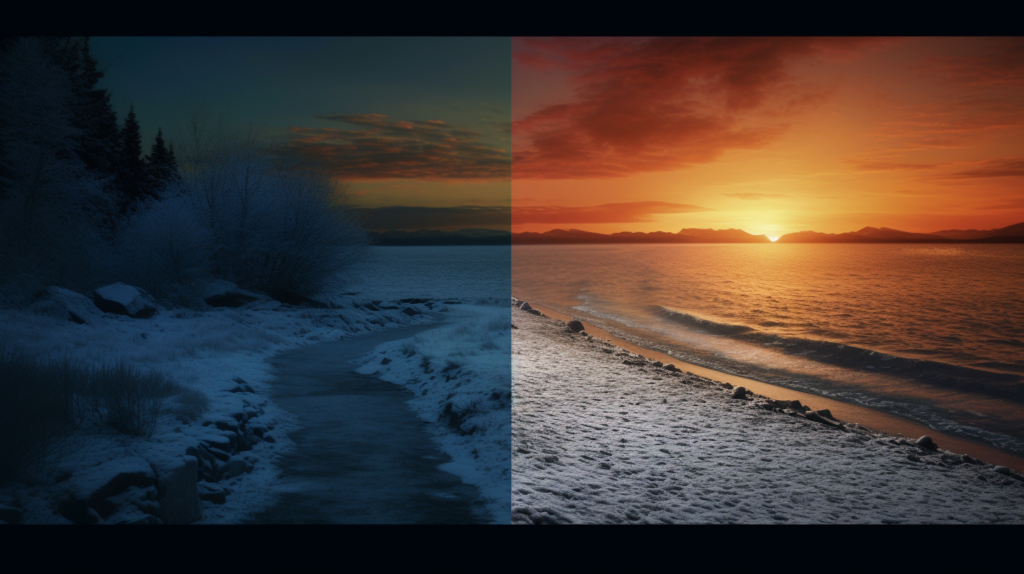
Daylight Saving Time
Daylight Saving Time (DST) alters sunrise and sunset times by one hour. When DST is in effect, from mid-March through early November, sunrise and sunset times are shifted later by one hour.
So in spring and summer, DST makes sunrise an hour later and sunset an hour later compared to standard time in the winter months. The impact of DST must be accounted for when looking up sunrise/sunset times.
Atmospheric Refraction
The Earth’s atmosphere bends and scatters sunlight, altering the perceived sunrise and sunset times slightly. This atmospheric refraction causes the sun to appear slightly higher on the horizon than its true geometric position.
Atmospheric conditions like temperature and pressure impact the amount of refraction. Under standard atmospheric conditions:
- Sunrise occurs when the sun is geometrically 50 arcminutes below the horizon but appears to be rising due to refraction.
- Sunset occurs when the sun is geometrically 50 arcminutes below the horizon.
So sunrise happens a few minutes earlier and sunset a few minutes later than the true geometric sunrise/sunset each day due to refraction.
Elevation and Obstructions
Local topography and obstructions on the horizon affect when the sun becomes visible each morning and when it drops out of sight each evening.
- Locations at higher elevations will see sunrise first as the sun appears over the horizon and will lose sunset last as the sun dips behind the horizon.
- Obstructions like mountains and buildings on the eastern or western horizon can block views of the actual sunrise and sunset.
To get a clear sunrise or sunset view, you often need an unobstructed view towards the east or west horizon.
How to Calculate Precise Sunrise and Sunset Times
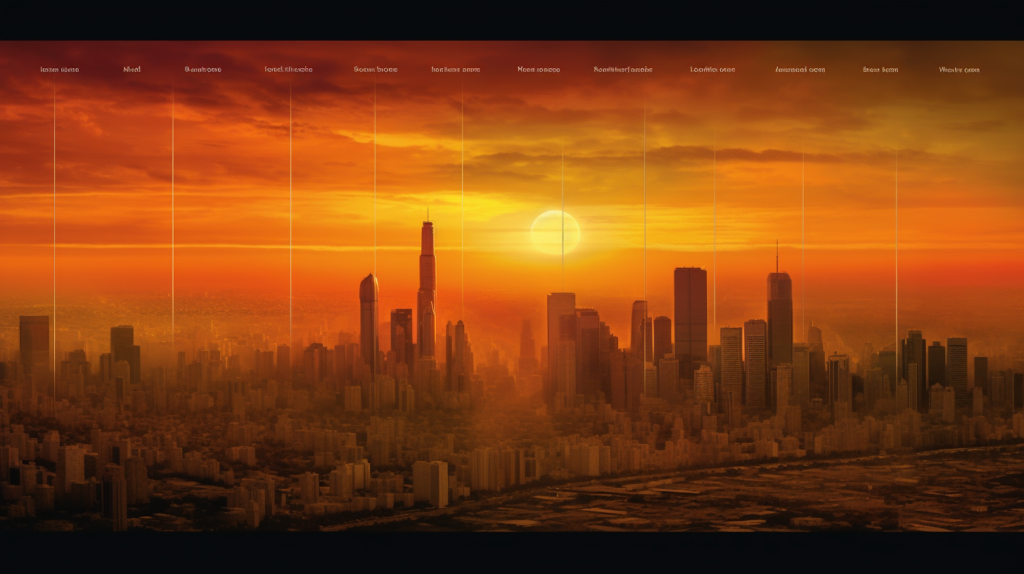
Now let’s go over how to calculate the exact sunrise and sunset times for your location on any given day. There are two main methods:
Use Online Sunrise/Sunset Calculators
Many free online tools and apps allow you to simply enter a location and date to lookup accurate sunrise and sunset times including:
- TimeandDate.com Sun Calculator
- Weather.gov Sunrise/Sunset Calculator
- SunriseSunset.com
- Golden Hour App – nice map-based app for photographers
These calculators use the latest astronomical data and formulas to account for all the factors like location, time of year, DST, and atmospheric refraction. They provide the most accurate sunrise/sunset times.
Calculate Manually Using Sunrise/Sunset Formulas
You can also calculate sunrise and sunset times yourself manually using astronomical formulas and a calculator. The formulas require:
- Your latitude and longitude
- The current date
Then based on some trigonometry and the sun’s position, you can compute the precise sunrise and sunset times down to the minute for a given date and location.
Here are the sunrise and sunset formulas:
Sunrise Time = Arcsin(cos(90.8333°)/(cos(Latitude)*cos(Declination))) + 180°)/15°
Sunset Time = Arcsin(cos(90.8333°)/(cos(Latitude)*cos(Declination)))/15°Where:
- Latitude = your latitude in degrees
- Declination = the sun’s current declination which varies by date
It may look complex, but you just need to input your location’s latitude and the sun’s declination on a given date. Plug them into the formulas to calculate the time in decimal hours, then convert to minutes to get your local sunrise and sunset times.
Apps like The Photographer’s Ephemeris provide a calculator tool to help make these computations for you.
How Sunrise and Sunset Times Change Throughout the Year
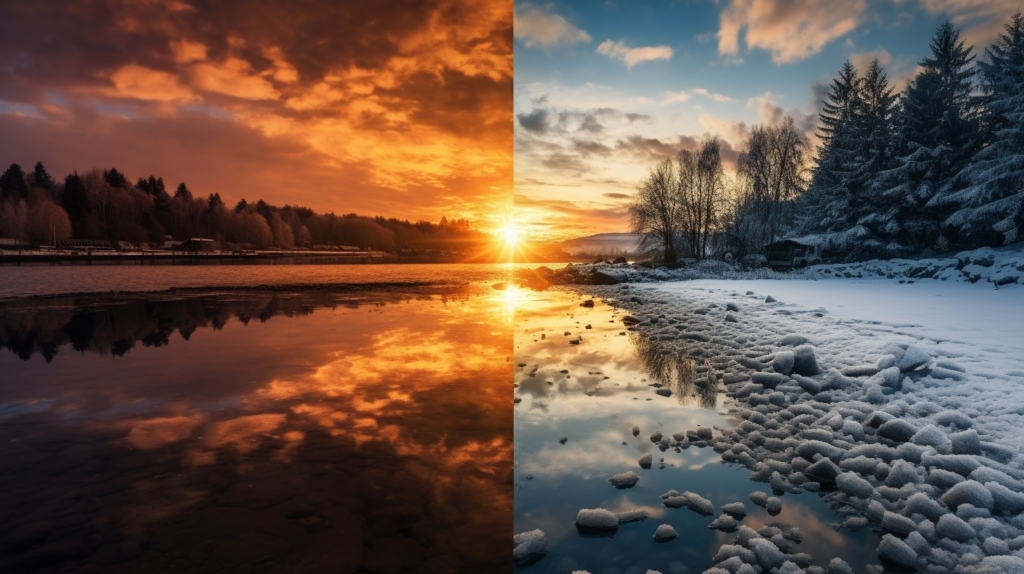
Now that we’ve covered the factors impacting sunrise and sunset times, let’s see how much variation actually occurs over the course of the year.
Using New York City as an example, here are the sunrise and sunset times for each month:
| Month | Sunrise Time | Sunset Time |
|---|---|---|
| January | 7:18 AM | 4:51 PM |
| February | 6:57 AM | 5:27 PM |
| March | 6:37 AM | 6:01 PM |
| April | 6:06 AM | 7:29 PM |
| May | 5:36 AM | 8:01 PM |
| June | 5:24 AM | 8:29 PM |
| July | 5:30 AM | 8:24 PM |
| August | 5:45 AM | 7:57 PM |
| September | 6:14 AM | 7:05 PM |
| October | 6:46 AM | 6:19 PM |
| November | 6:33 AM | 4:45 PM |
| December | 7:13 AM | 4:35 PM |
In New York, the earliest sunrise is at 5:24 AM in early June while the latest sunrise is at 7:18 AM in early January – a difference of almost 2 hours!
Sunset ranges from 4:35 PM in early December to 8:29 PM in late June – a staggering 3 hour 54 minute difference!
The further north you are, the more variance you’ll see between summer and winter sunrise/sunset times. Closer to the equator there is less seasonal difference.
Sunrise and Sunset Azimuths

The sun’s orientation relative to due east and due west at sunrise and sunset also changes slightly over the course of the year due to the tilt of the Earth’s axis.
- On the spring and fall equinoxes the sun rises precisely due east and sets precisely due west anywhere on Earth.
- On the summer solstice the sun rises at its furthest point north of due east and sets at its furthest point north of due west.
- On the winter solstice the sun rises at its furthest point south of due east and sets at its furthest point south of due west .
For example, in New York City on the summer solstice sunrise is oriented 70° north of east and sunset is 70° north of west. On the winter solstice, sunrise is 70° south of east and sunset 70° south of west.
The maximum variance is 90° between the summer and winter solstice. Closer to the equator, the variance is less. Right on the equator there is no change in sunrise/sunset azimuth throughout the year – it’s always due east and west.
Sunrise and Sunset Duration
In addition to sunrise and sunset times changing, the durations of sunrise and sunset are longer in winter and shorter in summer. This is due to the shallower angle that the sun rises and sets during winter months.
- Winter sunrises and sunsets last around 2 minutes on average near the equator and can be 5-8 minutes long closer to the poles.
- Summer sunrises and sunsets see the sun pop above or dip below the horizon in under 2 minutes, even at higher latitudes.
So in winter you get to enjoy those beautiful sunrise and sunset colors for a longer period of time each day.
Twilights and Golden Hours
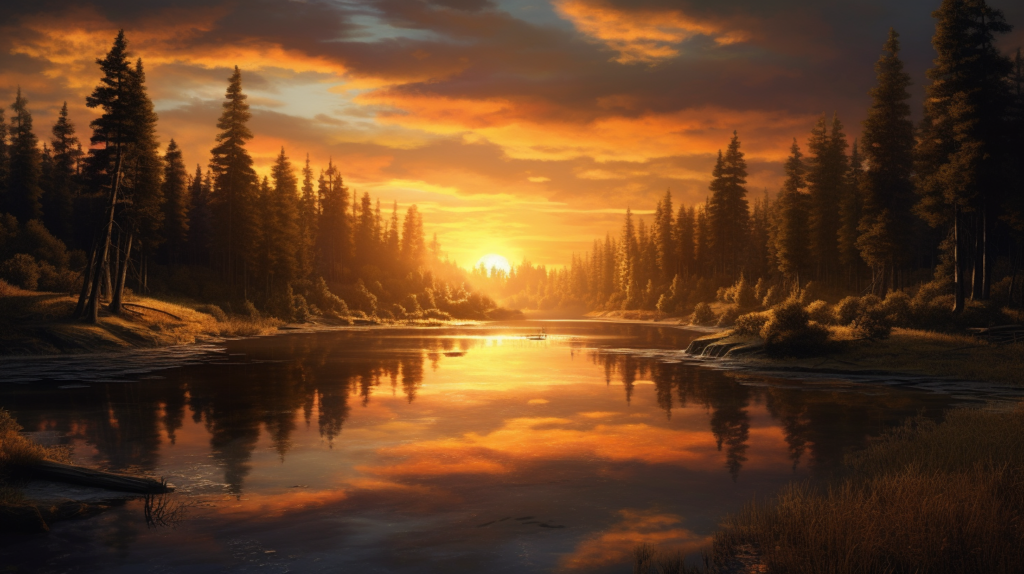
In addition to official sunrise and sunset, photographers and sky gazers pay close attention to civil, nautical, and astronomical twilights.
Twilight is the time between sunset and darkness in the evening or between darkness and sunrise in the morning when the sun is below the horizon but some sunlight still reaches the sky.
There are 3 stages of twilight defined by how far below the horizon the sun sits:
Civil Twilight
Civil twilight begins/ends when the sun is 6° below the horizon in the morning/evening. There is still enough light during civil twilight to carry on general outdoor activities without artificial lighting.
Morning civil twilight marks the start of golden hour – a time of soft,diffuse lighting that photographers love.
Nautical Twilight
Nautical twilight begins/ends when the sun reaches 12° below the horizon. During nautical twilight, the brighter stars used for celestial navigation begin to appear but there is still some ambient light.
Astronomical Twilight
Astronomical twilight begins when the sun is 18° below the horizon. This very low level of light is relied on by astronomers making observations. By the end of astronomical twilight when the sun reaches 18° below the horizon, the sky is quite dark.
So from sunrise through civil twilight in the morning or sunset through civil twilight in the evening marks the “golden hour” prized by photographers for its quality of light. Twilight also impacts when stars are visible and outdoor activities feasible after sunset or before sunrise.
Sunrise and Sunset by Location

Sunrise and sunset times vary not just day by day or season by season. They also shift based on your longitude and latitude location around the globe.
Here is an overview of how sunrise and sunset times change by latitude:
Tropical and Equatorial Latitudes (0° to 23° N/S)
At tropical and equatorial latitudes near the equator, seasonal variance in sunrise/sunset times is minimal through the year. The sun rises close to 6 AM and sets around 6 PM everyday. Some examples:
- Nairobi, Kenya (1° S): Sunrises ~6:20 AM, sunsets ~6:30 PM year-round
- Singapore (1° N): Sunrises ~7 AM, sunsets ~7:15 PM year-round
- Jakarta, Indonesia (6° S): Sunrises ~5:30 AM, sunsets ~5:45 PM year-round
Subtropical Latitudes (23° to 35° N/S)
Subtropical regions like southern Florida, southern China, and northern Africa experience slightly more variance in sunrise/sunset times. Summers have earlier sunrises and later sunsets while winter has delayed sunrises and earlier sunsets. Some examples:
- Miami, Florida (26° N): summer sunrises ~6:30 AM, winter sunrises ~7:15 AM
- Shanghai, China (31° N): summer sunrises ~5 AM, winter sunrises ~6:40 AM
- Cairo, Egypt (30° N): summer sunrises ~5 AM, winter sunrises ~6:45 AM
Temperate Latitudes (35° to 50° N/S)
Temperate regions like the southern US, southern Europe, and northern China see moderate seasonal shifts in sunrise/sunset times. Some examples:
- Dallas, Texas (33° N): summer sunrises ~6:30 AM, winter sunrises ~7:15 AM
- Rome, Italy (42° N): summer sunrises ~5:30 AM, winter sunrises ~7:15 AM
- Beijing, China (40° N): summer sunrises ~4:30 AM, winter sunrises ~7 AM
Subpolar Latitudes (50° to 70° N/S)
Subpolar regions like Alaska, Scandinavia, and southern Canada/Chile experience extreme seasonal shifts in sunrise and sunset times but don’t quite get 24 hours of daylight or darkness. Those places also famous beacuse of Nothern light, called Aurora Borealis, Some examples:
- Stockholm, Sweden (59° N): summer sunrise ~3 AM, winter sunrise ~8:30 AM
- Edmonton, Canada (53° N): summer sunrise ~5 AM, winter sunrise ~8:15 AM
- Anchorage, Alaska (61° N): summer sunrise ~4 AM, winter sunrise ~10 AM
Polar Latitudes (70° to 90° N/S)
The polar regions within the Arctic and Antarctic circles experience at least one day with 24 hours of sunlight (summer) and one day with 24 hours of darkness (winter) each year. Some examples:
- Tromsø, Norway (70° N): Polar night from late November into January. Midnight sun from late May into July.
- Murmansk, Russia (69° N): More than 50 days annually with no sunrise or sunset.
- Ushuaia, Argentina (54° S): Around 18 hours of daylight in December vs. 6 hours in June.
So latitude has a dramatic impact on sunrise and sunset patterns, especially as you near the poles and experience extreme shifts in day length and the presence or absence of daylight during parts of the year.
Sunrise and Sunset by Longitude
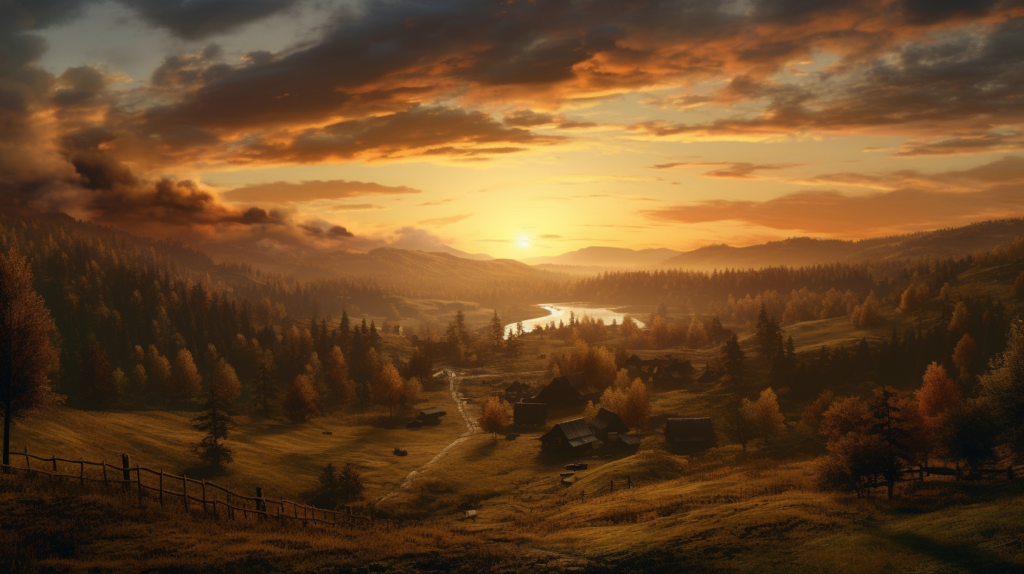
Your east-west position on the globe also impacts sunrise and sunset times but in a predictable way. Locations farther to the east see earlier sunrises and earlier sunsets compared to locations farther west at the same latitude.
Some examples:
- Boston vs. Los Angeles:
Boston longitude: 71° W
Los Angeles longitude: 118° W
Boston’s sunrises and sunsets are approximately 1 hour earlier than Los Angeles through the year.
- Paris vs. Cape Town:
Paris longitude: 2° E
Cape Town longitude: 18° E
Paris sunrise and sunsets are up to 1 hour later than Cape Town’s at equivalent times of year.
So moving east to west, you can expect sunrise and sunset times to shift later by 4 minutes for each degree of longitude, or 1 hour for every 15 degrees of longitude, that you shift.
Unique Sunrises and Sunsets Around the World
Certain landmarks around the world offer the opportunity to experience sunrise and sunset like nowhere else:
- Haleakala Crater, Hawaii – Watch the sun rise through the clouds over this massive volcanic crater on Maui.
- Uluru, Australia – See the sun set over the iconic red sandstone monolith, sacred to indigenous Australians.
- Annapurna Range, Nepal – View the first rays of sun hitting the Himalayan mountain peaks at Poon Hill.
- Borobudur Temple, Indonesia – The sun passing over this beautiful Buddhist temple creates stunning morning light and shadows.
- Serengeti National Park, Tanzania – A safari lets you see African wildlife bathed in golden sunrise and sunset lighting.
- Porthleven, England – Watch the sun set into the Atlantic through the iconic harbor pier at this Cornish village.
Chasing sunrise and sunset at these bucket list locales offers once-in-a-lifetime photo opportunities and memories.








